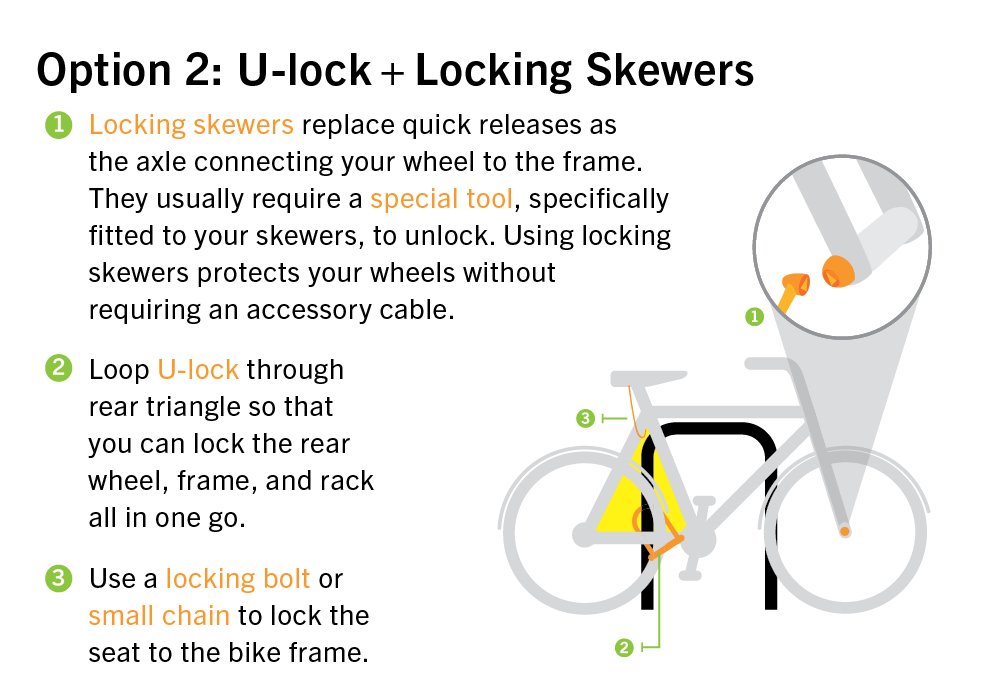
The SF Bicycle Coalition takes bike theft very seriously and recognizes that fear of theft is a barrier to people biking for everyday transportation. We offer education about preventing theft and how to avoid buying stolen bikes in order to disrupt demand in the stolen-bike market. If your questions are not answered below, please email cecilia@sfbike.org.
Precautions
Write down your bike’s serial number in a safe location, take photos, and keep all receipts.
If you have the bike’s unique serial number, it will help you verify that your bike belongs to you if it is stolen. The serial number is usually found under the bike frame’s bottom bracket, where the pedal cranks meet. Keep receipts for the original purchase of your bike and of any significant components you purchase for it, and take photos that will help identify your bike.

Obtain renters or homeowners insurance.
If you’re able to, consider obtaining renters or homeowners insurance. These insurance policies are relatively low-cost and will often cover most of the replacement cost if your bike is stolen. Make sure that the policy you purchase covers your possessions even when theft occurs outside the home — most do. Please note, however, that all insurance policies will rely on police reports to confirm thefts.
Bike tracking devices.
GPS and alarm devices, such as Boomerang and Sherlock, are options that promise to locate your bike if it is stolen. There is a wide array of products, and many of them require an ongoing subscription payment. We have not tested these products and thus cannot speak to their effectiveness
Bike Locking
Lock your bike well every time, and in safer locations
Well-lit, highly-trafficked areas are less likely to be targeted by someone stealing a bike. Make sure that whatever you are locking to is unmoveable (if a signpost, for example, tug on it before locking to it). Never lock your bike to a tree. And lock your bike even in seemingly secure, though unmonitored, locations, like garages and storage rooms. Here’s how we recommend locking your bike in a garage, storage locker, or home.
Proper Locking Techniques
Stolen Bikes
Take as many notes as possible.
Take photos of the location where your bike was parked when it was stolen. If a cut or broken lock was left behind, get pictures of that as well. Note the exact location, date and approximate time of the theft. Gather all documentation of your bike (make, model, color, serial number, any distinguishing characteristics, receipts) in a single location.
Search for your bike.
The person who stole your bike is almost certainly trying to sell it. Keep an eye on craigslist across the Bay Area by searching for the make, model, and color of your bike, along with any other unchangeable characteristics. You can set up email alerts for your craigslist search as well. People have found stolen bikes at several flea markets in the area, including San Jose (Wednesday, Friday); Coliseum (Saturday); Laney College (Sunday). Also monitor apps for selling used items, such as OfferUp and LetGo.
If you find your bike.
First, make sure that this is actually your bike before you do anything. Is the serial number the same? Are there unique identifiable characteristics? Also, remember that the person currently in possession of your bike might not be the person who stole it. We strongly urge everyone to consider the potential impact of calling the police on this person’s life. Please do not approach someone in possession of your bike alone.
Do you plan to file an insurance claim?
If so, your insurance plan will require a police report to support your claim. Our recommendations generally avoid involving the police whenever possible to minimize harm to Black and brown people. Since a police report is necessary for insurance claims, we recommend avoiding in-person contact by filing your police report online — insurance companies will consider online reports for theft exactly the same as in-person reports. In SF, go here to file a report.
Considerations
Bike Theft and Policing:
Black and brown people are often deeply harmed or even killed by interactions with the police, and the San Francisco Bicycle Coalition decided in 2020 to end any formal relationship with SFPD. Because policing is interwoven into nearly all current solutions to bike theft, some of our recommendations do involve minimal contact with the police, but we identify those and try to propose alternatives. We encourage everyone to consider the potential impact to human life of involving the police in any situation.
A note about bike registries:
Bike registries allow owners to register their bike’s make, model, and serial number, to help reconnect recovered bikes with their original owners. However, they also largely rely on the police for recovery and solicit close police partnerships. Because these services rely heavily on the police to find and recover bikes, which may put Black and brown lives at risk, we do not recommend them.



